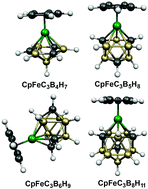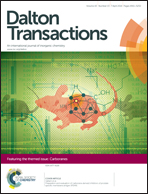Deltahedral ferratricarbaboranes: analogues of ferrocene†
Abstract
The neutral ferratricarbaboranes (η5-RC3B8H10)Fe(η5-C5H5) (R = aryl), analogues of ferrocene, have recently (2013) been synthesized by Štíbr and co-workers and structurally characterized by X-ray crystallography. We have now used density functional theory to study the structures of the complete series of related ferratricarbaboranes CpFeC3Bn−4Hn−1 (n = 8 to 12). The lowest energy structures are found to have the maximum number of carbon atoms at degree 4 rather than at degree 5 vertices and avoid adjacent carbon atoms, i.e., C–C edges. This can lead to structures deviating from the most spherical closo deltahedra. For the 8-vertex CpFeC3B4H7 system, hexagonal bipyramidal structures are found to be of comparable energy to the closo bisdisphenoidal structures. For the 9-vertex CpFeC3B5H8 system the unique closo tricapped trigonal prismatic structure having carbon atoms at the three non-adjacent degree 4 vertices lies ∼16 kcal mol−1 below the next lowest energy structure. The 10-vertex CpFeC3B6H9 system has the most complicated potential energy surface of the CpFeC3Bn−4Hn−1 structures with nine structures within 13 kcal mol−1 of the global minimum. Six of these nine structures are based on the closo bicapped square antiprism, which has only two degree 4 vertices for carbon atoms. The remaining three low-energy CpFeC3B6H9 structures are derived from the isocloso 10-vertex deltahedron with the iron atom at the unique degree 6 vertex and all three carbon atoms at degree 4 vertices. The low-energy 11-vertex CpFeC3B7H10 structures are based on the 11-vertex closo/isocloso deltahedron with the unique structure having the iron atom at the degree 6 vertex, carbon atoms at the two degree 4 vertices, and no C–C edge being the lowest energy structure. The lowest energy 12-vertex CpFeC3B8H11 structures are all based on the regular icosahedron with the three lowest energy structures having no C–C edges. The two lowest energy CpFeC3B8H11 structures correspond to those recently found experimentally in the (η5-RC3B8H10)Fe(η5-C5H5) (R = aryl) systems.

- This article is part of the themed collection: Carboranes

 Please wait while we load your content...
Please wait while we load your content...